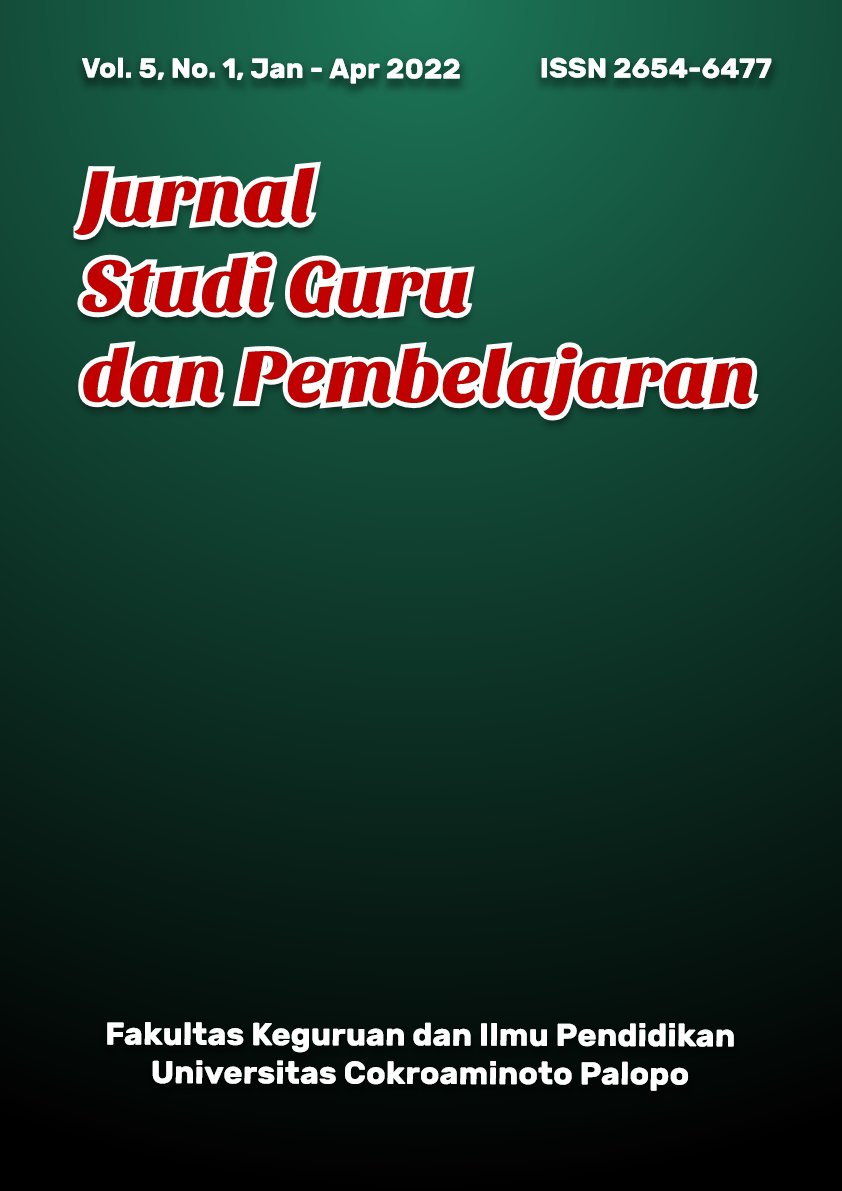Implementasi Microlearning Berbasis Case Study Terhadap Hasil Belajar Mahasiswa Pendidikan Kimia
DOI:
https://doi.org/10.30605/jsgp.5.1.2022.1530Keywords:
Microlearning, Case Study, Hasil Belajar, Mahasiswa, Pendidikan KimiaAbstract
Kebutuhan karakteristik generasi zaman now terhadap pembelajaran daring menghadirkan style baru penyajian konten perkuliahan dengan microlearning. Implementasi microlearning membutuhkan model pembelajaran yang tepat berorientasi self-directed learning case study. Untuk menjawab tantangan tersebut maka dibutuhkan implementasi best practice dan pengaruhnya (efektivitas) dalam perkuliahan. Desain penelitian ini adalah Pre-Experimental Design dengan One Group Pretest-Posttest. Subjek penelitian ini adalah 25 mahasiswa mata kuliah metodologi Penelitian Pendidikan yang terdaftar pada Prodi Pendidikan Kimia Tahun Ajaran 2021-2022. Teknik pengumpulan data berupa tes dan non tes, serta dokumentasi. Data dianalisis dan diolah menjadi data interval menggunakan skala Likert. Untuk teknik analisis data yaitu menggunakan uji normalitas, homogenitas, serta T-Test. Tahapan pada penelitian ini meliputi pra eksperimen, eksperimen, dan pasca eksperimen. Hasil penelitian ini menunjukkan bahwa pada tahap pra eksperimen, peneliti mempersiapkan set perangkat perkuliahan dengan style microlearning berbasis case study. Hasil eksperimen diketahui best practice penerapan microlearning berbasis case study dengan alur: 1) introduction microlearning, concepts, tools, and student’s group; 2) teaching by traditional learning; 3) teaching by microlearning; 4) students evaluations, examination, and feedback; dan 5) comparison between traditional learning and microlearning. Pasca eksperimen dilakukan evaluasi capaian(efektivitas) implementasi micro learning berbasis case study, dengan perolehan hasil uji t sebesar 7,769 membuktikan bahwa terdapat pengaruh implementasi microlearning berbasis case study terhadap hasil belajar mahasiswa. Adapun implementasi microlearning berbasis case study dapat dilaksanakan secara blended learning untuk meminimalisir hambatan yang dihadapi mahasiswa.
Downloads
References
Alodianada, H., Widyaningrum, R., & Nursetyo, K. I. (2019). Rancangan Pembelajaran Flipped Classroom untuk Mata Kuliah Persepsi Desain dan Pesan. Jurnal Pembelajaran Inovatif, 2(2) 144-149. DOI: https://doi.org/10.21009/JPI.022.08
Corbeil, J. R., Khan, B. H., & Corbeil, M. E. (Eds.). (2021). Microlearning in the Digital Age: The Design and Delivery of Learning in Snippets. Routledge. DOI: https://doi.org/10.4324/9780367821623
Faizah, N. O., Sudatha, I. G. W., & Simamora, A. H. (2020). Pengembangan Multimedia Pembelajaran IPA untuk Meningkatkan Hasil Belajar. Journal of Education Technology, 4(1), 52-58. DOI: https://doi.org/10.23887/jet.v4i1.24091
Jultri, S. (2021). Desain Pembelajaran Pedati Sebagai Alternatif Pengembangan Metode Asinkron. In Prosiding Seminar Nasional Pembelajaran Bahasa dan Sastra Indonesia (SemNas PBSI)-3 (pp. 61-66). FBS Unimed Press.
Karam, M., Fares, H., & Al-Majeed, S. (2021). Quality Assurance Framework for the Design and Delivery of Virtual, Real-Time Courses. Information Journal, 12(2) DOI: https://doi.org/10.3390/info12020093
Kemdikbud. (2020). Buku Panduan Merdeka Belajar-Kampus Merdeka. Jakarta: Kementerian Pendidikan Kebudayaan dan Riset dan Teknologi. DOI: https://doi.org/10.31219/osf.io/ujmte
Kokotsaki, D., Menzies, V., & Wiggins, A. (2016). Project-based learning: A review of the literature. Improving Schools, 19(3), 267–277. DOI: https://doi.org/10.1177/1365480216659733
Leong, K., Sung, A., Au, D. dan Blanchard, C. (2021). A review of the trend of microlearning", Journal of Work-Applied Management, 13(1), pp. 88-102. DOI: https://doi.org/10.1108/JWAM-10-2020-0044
Olivier, J. (2021). Creating Microlearning Objects within Self-Directed Multimodal Learning Contexts. in Microlearning in the Digital Age. Routledge, 169-188. DOI: https://doi.org/10.4324/9780367821623-15
Rafli, M. A., & Adri, M. (2022). Pengembangan Micro-Learning Pada Mata Kuliah Kewirausahaan di Universitas Negeri Padang Berbasis Media. Jurnal Pendidikan Tambusai, 6(1), 1149-1156.
Sirwan Mohammed, G. , Wakil, K. & Sirwan Nawroly, S. (2018). The Effectiveness of Microlearning to Improve Students’ Learning Ability. International Journal of Educational Research Review , 3(3), 32-38. DOI: DOI: https://doi.org/10.24331/ijere.415824
Sukma, Y., & Priatna, N. (2021). The Effectiveness of Blended Learning on Students’ Critical Thinking Skills in Mathematics Education: A Literature Review. In Journal of Physics: Conference Series. 1806(1), 012071. DOI: https://doi.org/10.1088/1742-6596/1806/1/012071
Wulandari, N., & Damris, M. (2011). Pengaruh problem based learning dan kemampuan berpikir kritis terhadap hasil belajar mahasiswa. Jurnal Tekno-Pedagogi, 1(1). DOI: https://doi.org/10.31332/kd.v1i1.1806
Zhang, J., & West E. (2020). Designing Microlearning Instruction for Professional Development Through a Competency Based Approach. TechTrends, 64(2), 310-318. DOI: https://doi.org/10.1007/s11528-019-00449-4
Downloads
Published
How to Cite
Issue
Section
License
In submitting the manuscript to the journal, the authors certify that:
- They are authorized by their co-authors to enter into these arrangements.
- The work described has not been formally published before, except in the form of an abstract or as part of a published lecture, review, thesis, or overlay journal.
- That it is not under consideration for publication elsewhere,
- That its publication has been approved by all the author(s) and by the responsible authorities – tacitly or explicitly – of the institutes where the work has been carried out.
- They secure the right to reproduce any material that has already been published or copyrighted elsewhere.
- They agree to the following license and copyright agreement.
License and Copyright Agreement
Authors who publish with JSGP agree to the following terms:
- Authors retain copyright and grant the journal right of first publication with the work simultaneously licensed under Creative Commons Attribution License (CC BY-SA 4.0) that allows others to share the work with an acknowledgement of the work's authorship and initial publication in this journal.
- Authors are able to enter into separate, additional contractual arrangements for the non-exclusive distribution of the journal's published version of the work (e.g., post it to an institutional repository or publish it in a book), with an acknowledgement of its initial publication in this journal.
- Authors are permitted and encouraged to post their work online (e.g., in institutional repositories or on their website) prior to and during the submission process, as it can lead to productive exchanges, as well as earlier and greater citation of published work.














